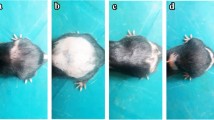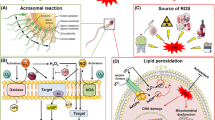Abstract
The effect of dehydroepiandrosterone sulfate on oxidative stress- and ethanol-induced morphological changes and the level of apoptotic enzymes (Bcl-2 and caspase-3) of lymphocytes in six healthy persons were studied. It was shown that hydroperoxide induced apoptotic changes in lymphocytes. The addition of ethanol to the culture medium caused no significant changes in the parameters studied. Dehydroepiandrosterone sulfate had a marked antiapoptotic effect on the peripheral blood lymphocytes of healthy subjects, protecting them from the harmful effects of reactive oxygen species.
Similar content being viewed by others
References
Pal’tsev, M.A., Ivanov, A.A., and Severin, S.E., Mezhkletochnye vzaimodeistviya (Cell-Cell Interactions), 2nd ed. (revised and extended), Moscow: Meditsina, 2003.
Herman, J.P. and Seroogy, K., Hypothalamic-Pituitary-Adrenal Axis, Glucocorticoids, and Neurologic Disease, Neurol. Clin., 2006, vol. 24, p. 461.
Charalampopoulos, I., Dermitzaki, E., Alexaki, V., et al., Dehydroepiandrosterone and Allopregnanolone Protect Sympathoadrenal Medulla Cells against Apoptosis via Antiapoptotic Bcl-2 Proteins, Proc. Natl. Acad. Sci. USA, 2004, vol. 101, p. 8209.
Leskiewich, M., Regulska, M., Budziszewsha, B., et al., Effects of Neurosteroids on Hydrogen Peroxide- and Staurosporine-Induced Damage of Human Neuroblastoma SH-SY5Y Cells, J. Neurosci. Res., 2008, vol. 86, p. 1361.
Shirakawa, H., Katsuki, H., Kume, T., et al., Regulation of N-Methyl-D-Aspartate Cytotoxicity by Neuroactive Steroids in Rat Cortical Neurons, Eur. J. Pharmacol., 2002, vol. 454, nos. 2–3, p. 165.
Purdy, R.H., Valenzuela, C.F., Janak, P.H., et al., Neuroactive Steroids and Ethanol, Alcohol Clin. Exp. Res., 2005, vol. 29, no. 7, p. 1292.
Schepis, T., Rao, U., and Adinoff, B., The Limbic-Hypothalamic-Pituitary-Adrenal Axis and the Development of Alcohol Use Disorders in Youth, Alcohol Clin. Exp. Res., 2011, vol. 35, no. 4, p. 595.
Ivanova, S.A., Vetlugina, T.P., Bokhan, N.A., and Epshtein, O.I., Immunobiology of Addictive Disorders: Mechanisms of Psychoneuroimmunomodulation, Sib. Vestn. Psikhiatr. Narkol., 2002, no. 1, p. 52.
Rodrigues, D.A., Moncada, C., Nunez, M.T., et al., Ethanol Increases Tumor Necrosis Factor-alpha Receptor-1 (TNF-R1) Levels in Hepatic, Intestinal, and Cardiac Cells, Alcohol, 2004, vol. 33, p. 9.
Sukhanova, G.A. and Akbasheva, O.E., Apoptoz (Apoptosis), Tomsk: Izd. TPU, 2006.
Brooks, P.J., Brain Atrophy and Neuronal Loss in Alcoholism: A Role of DNA Damage?, Neurochem. Int., 2000, vol. 37, p. 403.
Ivanova, S.A., Vyalova, N.M., Zhernova, E.V., and Bokhan, N.A., Spontaneous and Induced In Vitro Apoptosis of Lymphocytes and Neutrophils in Patients with Alcohol Addiction, Byull. Eksp. Biol. Med., 2010, vol. 149, no. 2, p. 209.
Spirodopolous, I., Wichhusen, J., Rabenshtein, B., et al., Alcohol Enhances Oxysterol-Induced Apoptosis in Human Endothelial Cells by a Calcium Dependent Mechanism, Arterioscler. Thromb. Vasc. Biol., 2001, vol. 21, p. 439.
Knyaz’kin, I.V. and Tsygan, V.N., Apoptoz v onkourologii (Apoptosis in Urology), St. Petersburg: Nauka, 2007.
Yakovlev, A.A., Gorokhovatskii, A.Yu., Onufreev, M.V., et al., Brain Cathepsin Is Able to Cleave Caspase Substrate, Biochemistry (Moscow), 2008, vol. 73, no. 3, p. 408.
Gondal, M., Holm, J., and Wigzell, H., Surface Markers on Human T and B Lymphocytes Forming Nonimmune Rosettes with Sheep Blood Cells, J. Exp. Med., 1972, vol. 136, no. 124, p. 207.
Smirnova, L.P., The Role of Active Enzyme in the Regulation of Proliferation of Tumor Cells, Extended Abstract of Cand. Sci. (Med.) Dissertation, Tomsk, 2003.
Bokhan, N.A. and Prokop’eva, V.D., Molekulyarnye mekhanizmy vliyaniya etanola i ego metabolitov na eritrotsity in vitro i in vivo (Molecular Mechanisms of Action of Ethanol and Its Metabolites on Red Blood Cells in vitro and in vivo), Tomsk, 2004.
Sheth, D., Tajuddin, N., and Druse, M., Antioxidant Neuroprotection against Ethanol-Induced Apoptosis in HN2-5 Cells, Brain Res., 2009, vol. 1285, p. 14.
Fil’chenkov, A.A. and Stoika, R.S., Apoptoz i rak (Apoptosis and Cancer), Kiev: Izd. NAN Ukraine, 1999.
Lushchak, V.I., Free Radical Oxidation of Proteins and Its Relationship to the Functional State of the Body, Biochemistry (Moscow), 2007, vol. 72, no. 8, p. 995.
Bürne, B., Knethen, A., and Sandau, K.B., Nitric Oxide and Its Role in Apoptosis, Eur. J. Pharmacol., 1998, vol. 351, p. 261.
Hortelano, S., Dallaporta, B., Zamzami, N., et al., Nitric Oxide Induces Apoptosis via Triggering Mitochondrial Permeability Transition, FEBS Lett., 1997, vol. 410, p. 373.
Tejedo, J.C., Cahuana, G.M., Ramírez, R., et al., NO Induces a CGMP-Independent Release of Cytochrome C from Mitochondria Which Precedes Caspase 3 Activation in Insulin Producing RINm5F Cells, FEBS Lett., 1999, vol. 459, p. 238.
Lyamzev, K.G., Mitochondria in Oxidative Stress in HeLa Cell Culture, Extended Abstract of Cand. Sci. (Biol.) Dissertation, Moscow, 2007.
Vasil’eva, O.A., Urazova, O.I., Serebryakova, V.A., et al., Assessment of the Effect of Rifampicin on Apoptosis of Peripheral Blood Lymphocytes in Patients with Pulmonary Tuberculosis, Nauki o Cheloveke, 2009, vol. 1, p. 72.
Zhukova, O.B., Ryazantseva, N.V., and Novitskii, V.V., Modulation of Programmed Death of Peripheral Blood Lymphocytes in Chronic Viral Infection, Tsitologiia, 2007, vol. 49, no. 1, p. 26.
Ryter, S., Kim, W., Hoetzel, H.P., et al., Mechanisms of Cell Death in Oxidative Stress, Antioxidants Redox Signal., 2007, vol. 9, no. 1, p. 49.
Lapchak, P.A., Chapman, D.F., Nuner, S.Y., et al., Dehydroepiandrosterone Sulfate Is Neuroprotective in a Reversible Spinal Cord Ischemia Model: Possible Involvement of GABAA Receptors, Stroke, 2000, vol. 31, no. 8, p. 1953.
Zhang, L., Li, B., Ma, W., et al., Dehydroepiandrosterone (DHEA) and Its Sulfated Derivative (DHEAS) Regulate Apoptosis during Neurogenesis by Triggering the Akt Signaling Patway in Opposing Ways, Brain Res. Mol. Brain Res., 2002, vol. 98, nos. 1–2, p. 58.
Li, H., Klein, G., Sun, P., et al., Dehydroepiandrosterone (DHEA) Reduces Neuronal Injury in a Ret Model of Global Cerebral Ischemia, Brain Res., 2001, vol. 888, no. 2, p. 263.
Charalampopoulos, I., Alexaki, V.I., Lazaridis, I., et al., G Protein-Associated, Specific Membrane Binding Sites Mediate the Neuroprotective Effect of Dehydroepiandrosterone, FASEB J., 2006, vol. 20, no. 3, p. 577.
Maninger, N., Wolkowitz, O.M., Reus, V.I., et al., Neurobiological and Neuropsychiatric Effects of Dehydroepiandrosterone (DHEA) and DHEA Sulfate (DHEAS), Front. Neuroendocrinol., 2009, vol. 30, no. 1, p. 65.
Takahashi, H., Nakajima, A., and Sekihara, H., Dehydroepiandrosterone (DHEA) and Its Sulfate (DHEAS) Inhibit the Apoptosis in Human Peripheral Blood Lymphocytes, J. Steroid Biochem. Mol. Biol., 2004, vol. 88, no. 3, p. 261.
Author information
Authors and Affiliations
Additional information
Original Russian Text © E.V. Zhernova, S.A. Ivanova, 2012, published in Fiziologiya Cheloveka, 2012, Vol. 38, No. 5, pp. 97–101.
Rights and permissions
About this article
Cite this article
Zhernova, E.V., Ivanova, S.A. Effects of dehydroepiandrosterone sulfate on induced apoptosis of lymphocytes in healthy persons. Hum Physiol 38, 534–538 (2012). https://doi.org/10.1134/S0362119712050143
Received:
Published:
Issue Date:
DOI: https://doi.org/10.1134/S0362119712050143




